消费者行为学英文版最新版教学课件第4章
合集下载
消费者行为学课件20120903第4章

返回
重庆大学城市科技学院
个性心理特征
含义:是一个人身上经常地、稳定地表现出 来的心理特征。
消费者的 气质
个性心理 特征
消费者的 能力
消费者的 性格
返回
重庆大学城市科技学院
4.1.2 个性的形成
先天生 理素质
遗传
物质 基础
个性
后天社 会环境 社会 属性 实践 活动 决定的
重庆大学城市科技学院
4.1.3
重庆大学城市科技学院
4.3.2 主要的气质学说
重庆大学城市科技学院
4.3.2 主要的气质学说
O型
血液说
A型 B型 AB型
重庆大学城市科技学院
4.3.2 主要的气质学说
细长体型
体形说
肥胖体型
筋骨体型
重庆大学城市科技学院
4.3.2 主要的气质学说
激素说
重庆大学城市科技学院
4.3.2 主要的气质学说
重庆大学城市科技学院
7、无忧无虑,顽皮,愉快的人
你喜欢自由自在,无拘无束的生活。 你的座右铭是:生命只能活一次,因此你尽量享受每 一刻。 你好奇心旺盛,对新事物抱有开放的态度;你向往改 变,讨厌束缚。 你觉得身边的环境都不断在变,而且经常为你带来惊 喜。 你是一个感性的人。你拒绝只从一个严肃,理智的角 度去理解事物。 你的感觉亦十分重要。事实上,你觉得人生必需要有 梦想才活得充实。 你不接受那些轻视浪漫主义及被理智牵着鼻子走的人。 不会让任何事物影响到你那丰富的感情及情绪。
5.性格的类型
按价值观念倾 向性分类
理论型
经济型 艺术型 社会型 政治型
பைடு நூலகம்
性格
宗教型
重庆大学城市科技学院
双语消费者行为学

3.2消费者行为与定价策略 1)比价心理: 2)价格习惯心理: 3)高价心理: 4)敏感性心理 5)从众心理
3.3消费者行为与促销策略 1.广告与消费行为 广告要想取得成功,必须符合消费者的心 理和行为特点。消费行为对广告的发布时 广告的主题与创意、广告的表现形式等都 有很大的影响
3.3消费者行为与促销策略
• • • • •
视觉 听觉 嗅觉 味觉 触觉
2.2基本传播过程
发送方的经验域
接收方的经验域
信源/ 发送方
反 馈
编码
信道讯息
解码
接收者
噪 音
反 应
第三章个性、自我概念与情绪 Personality, Self and Emotion
CH1
难点:个性的含义
Personality implication
3.4自我概念的含义
自我概念是指一个人所持有的关于自身特征的信念, 以及他(她)对于这些特征的评价 The self-concept refers to the beliefs a person holds about his or her own attributes and how he or she evaluates these qualities.
消费者行为
获得 如何决定购买 考虑购买的其他产品 哪里购买 如何将产品运送到家 消费 如何使用产品 如何贮存产品 谁使用产品 消费多少产品 产品与期望相比如何
处置 如何消除剩余产品 使用后丢弃多少 是自己再买产品还是通过 邮购商店买产品 如何循环利用一些产品
2.销售促销与消费者行为 消费者行为的研究对品牌、定位到差异化,从定 价、促销到整合营销,莫不都是在针对消费者 的行为在采取行动。现在的市场营销将越来越 依赖于对消费者行为的把握和迎合,从而影响 消费者,最终达成产品的销售。
《消费者行为学》教学课件 第4章 消费者知觉、学习与记忆

人体的某一感觉器官的感受性因其他感觉器官受到刺激 而发生变化的现象,称为不同感觉之间的相互作用。在 一定条件下,各种感觉发生相互影响的一般规律是:对 某一感觉的弱刺激能提高另一种感觉的感受性,而强刺 激那么会使这种感受性降低。例如人的听觉在黑暗的环 境中会变得更加灵敏;微弱的声响,那么能刺激、提高 视觉对颜色的感受性。
4.1 知觉与消费者行为
4.1.1 消费者的感觉 1〕感觉及其产生 2〕感觉的分类
根据感觉的性质可把感觉分为外部感觉和内部 感觉两大类。 3〕感觉性和感觉阈限
感觉性就是人的感觉能力。感觉性的大小是用 能引起感觉并持续了一定时间的刺激量,即感觉 阈限来衡量的。
4.1 知觉与消费者行为
4)感觉的适应 人的感觉器官在客观事物的持续刺激作用下导致感
销售科长听了大家的发言,最后说,“这些年大家在这 样差的条件下,为公司做出很大奉献。现在消费者要求 高了,没有良好的销售环境,会影响消费者对我们公司 的印象,破门破户像地摊售货,直接影响顾客对产品的 感觉,长此以往,我们产品的知名度会降低,销售不容 乐观。南方一家产品行销全国的冰箱厂,进去后感觉像 到了三星级饭店,可以想象企业资金雄厚,欣欣向荣, 买这样企业生产的产品消费者自然放心。我打算给公司 写个报告,从感觉、知觉与认识商品,想象、思维、情 绪、情感与消费者购物等方面,说明购物环境对促进冰 箱销售的重要作用,恳请公司领导同意拨款,装修改造 销售科门市。〞
“我怕那是假月饼,就把它给扔了。〞月饼不敢再吃, 盒子留着也多余,周女士就把它扔到了垃圾桶旁。谁知 门口收破烂的看到后,像捡到宝贝一样赶快捡起来,还 把包装纸一张张叠好抚平,放进礼品盒内。在周女士的 一再追问下,收破烂的道出实情:月饼盒可以卖,中秋 节前,好些食品城的商户都在高价回收月饼礼盒,他就 准备卖给航海路上的一家食品城。
消费者行为学第4版PPT绪论[17页]
![消费者行为学第4版PPT绪论[17页]](https://img.taocdn.com/s3/m/3c7bfee5fc4ffe473268ab0f.png)
消费者行为学的学科特征和发展趋势
消费者行为学的学科特征
跨学科交叉和多 元的的方法
研究与应用并重
消费者行为学的发展趋势
1 数智化消费者行为学正在兴起 2 研究重心从单个人转到网络关系中的人 3 研究不同文化背景下的消费者行为 4 更强调理论的应用
数智化消费者行为学
1. 数字化消费者行为的概念由来
消费者行为学
我们绪毕论业啦 其实是答辩的标题地方
导论 消费者行为学的基本范畴与学科特征 数智化消费者行为学
消费者行为学的 基本范畴与学科特征
消费者行为学的基本范畴 mer behavior)涵盖了 很多方面,它研究个体或群体为满足需要与欲 望而挑选、购买、使用或处置产品、服务、观 念或体验所涉及的过程。
2. 数智化消费者行为与传统消费者行为 的根本区别
新的行为模式: 传统人和数字人
新的洞察方法: 消费者行为分析 的算法
3. 数智化消费者行为学的新概念
表0-1 数智化消费者行为的新概念
延伸阅读0-1 消费者行为学50年:演进与颠覆
消费者行为学
THANKS
消费者研究(如经济人、非理性人等) 消费者行为研究
4. 全球代表性的消费者行为学教材
恩格尔版本,1968年第1版,自2001年第9版起为 布莱克韦尔版本,2006年出至第10版。
希夫曼版本,1978年第1版,2018年第12版。 霍金斯版本,1980年第1版,2018年第13版。 所罗门版本,1991年第1版,2017年第12版。
5. 消费者行为的研究
“
消费者行为学的知识来源于消费者行为研究 消费者行为研究属于属于行为科学(behavioral
sciences)和消费者研究(consumer research)的更大范
消费者行为学(Consumer-Behavior)PPT优秀课件

Key Concepts
Role Theory
Different Actors
Process Involving Exchange
Organizations or Groups
Copyright 1999 Prentice Hall
Consumers Impact on Marketing 1-3 Strategy
Express Aspects of Self or Society
Consuming as Classification
Communicate Their Association With Objects, Both to Self/ Others
Consuming as Play
Participate in a Mutual Experience and Merge Self Wห้องสมุดไป่ตู้th Group
• Relationship Marketing occurs when a company makes an effort to interact with customers on a regular basis, and gives them reasons to maintain a bond with the company over time.
Copyright 1999 Prentice Hall
Semiotics: The Symbols Around Us 1-8
Semiotics is the Study of How Consumers Interpret the Meaning of Symbols.
Copyright 1999 Prentice Hall
Role Theory
Different Actors
Process Involving Exchange
Organizations or Groups
Copyright 1999 Prentice Hall
Consumers Impact on Marketing 1-3 Strategy
Express Aspects of Self or Society
Consuming as Classification
Communicate Their Association With Objects, Both to Self/ Others
Consuming as Play
Participate in a Mutual Experience and Merge Self Wห้องสมุดไป่ตู้th Group
• Relationship Marketing occurs when a company makes an effort to interact with customers on a regular basis, and gives them reasons to maintain a bond with the company over time.
Copyright 1999 Prentice Hall
Semiotics: The Symbols Around Us 1-8
Semiotics is the Study of How Consumers Interpret the Meaning of Symbols.
Copyright 1999 Prentice Hall
消费者行为学英文版最新版教学课件第1章
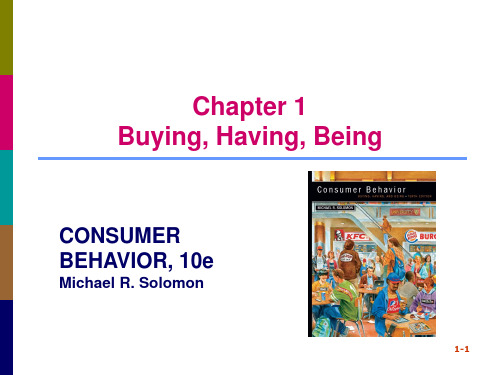
1-26
Learning Objective 6
Many specialists study consumer behavior.
Disciplinary Focus
Product Role
Experimental Psychology Perception, learning, and memory processes
define their identities in different settings.
2. Consumer behavior is a process. 3. Marketers need to understand the wants
and needs of different consumer segments.
• Products are designed to meet existing
needs;
• Advertising only helps to communicate
their availability
1-23
Do Marketers Promise Miracles?
• Advertisers simply
communication, conveyance, collaboration, and cultivation among interconnected and interdependent networks of people, communities, and organizations enhanced by technological capabilities and mobility.
Marketers influence preferences for movie and music heroes, fashions, food, and decorating choices.
Learning Objective 6
Many specialists study consumer behavior.
Disciplinary Focus
Product Role
Experimental Psychology Perception, learning, and memory processes
define their identities in different settings.
2. Consumer behavior is a process. 3. Marketers need to understand the wants
and needs of different consumer segments.
• Products are designed to meet existing
needs;
• Advertising only helps to communicate
their availability
1-23
Do Marketers Promise Miracles?
• Advertisers simply
communication, conveyance, collaboration, and cultivation among interconnected and interdependent networks of people, communities, and organizations enhanced by technological capabilities and mobility.
Marketers influence preferences for movie and music heroes, fashions, food, and decorating choices.
消费者行为的英语PPT课件
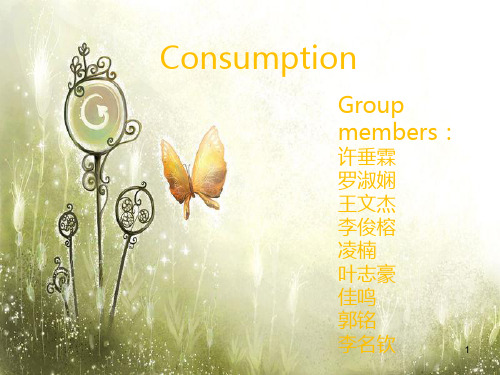
• (那么这些消费行为在我们的生活中又有 那些变化和意义呢)
2
On the consumption problem
• What is consumer behavior?
• (什么是消费行为) • How to make rational consumption? • (如何做到理性消费) • What is the role of consumer behavior on
• 可持续发展经济不可 能在一夜之间改变, 这将需要几十年才能 创建一个可持续发展 的经济。但是,你可 以现在就开始学习由 少变多
6
2020/1/13
7
Try incorporating these tips into your life
• 1. Diversify your income stream.
• 使你的收入多元化
• 3. Be an environmentally aware consumer.
• 做个懂得尊重环境的 消费者
• 2. Make, grow, and do things yourself.
• 自己动手,丰衣足食 • 4. Connect with
your community. • 与社区紧密联系
• 个人的行为,在微观层面上, 可以在宏观层面上作出了巨大 的差异。注意自己的消费模式 是开始的最好的地方。然后你 就可以开始把你的日常行为的 变化。
• 比如你可以停止购买瓶装水或 者一次性物品;骑单车做到绿 色出行;购买本地产品;修补 你的鞋子,衣物;不浪费你餐 桌上的食品;保持你家里的环 境卫生等等装。
Consumption
Group
members:
许垂霖
罗淑娴
2
On the consumption problem
• What is consumer behavior?
• (什么是消费行为) • How to make rational consumption? • (如何做到理性消费) • What is the role of consumer behavior on
• 可持续发展经济不可 能在一夜之间改变, 这将需要几十年才能 创建一个可持续发展 的经济。但是,你可 以现在就开始学习由 少变多
6
2020/1/13
7
Try incorporating these tips into your life
• 1. Diversify your income stream.
• 使你的收入多元化
• 3. Be an environmentally aware consumer.
• 做个懂得尊重环境的 消费者
• 2. Make, grow, and do things yourself.
• 自己动手,丰衣足食 • 4. Connect with
your community. • 与社区紧密联系
• 个人的行为,在微观层面上, 可以在宏观层面上作出了巨大 的差异。注意自己的消费模式 是开始的最好的地方。然后你 就可以开始把你的日常行为的 变化。
• 比如你可以停止购买瓶装水或 者一次性物品;骑单车做到绿 色出行;购买本地产品;修补 你的鞋子,衣物;不浪费你餐 桌上的食品;保持你家里的环 境卫生等等装。
Consumption
Group
members:
许垂霖
罗淑娴
消费者行为学4

两性期。儿童这时已从一个自私的、追求 快感的孩子转变成具有异性爱权力的、社会化 的成人。弗洛伊德认为这一时期如果不能顺利 发展,儿童就可能产生性犯罪、性倒错,甚至 患精神病。
(二)荣格的个性类型说
人格结构由很多两极相对的内动 力所形成,如感觉对直觉;思维对情 感;外倾对内倾等等。具体到一个人 身上,这些彼此相对的个性倾向常常 是失衡的或有所偏向。
气质类型 阴阳五行说(春秋战国)——金、木、水、火、土五 种类型,不同类型有不同的体质形态、肤色、腺性和气质。
※体型说( 德国)——细长体型(分裂气质)
胖体型(狂躁气质)筋骨体型(黏着气质)
※“四根”说( 古希腊)——身体的固体部 分是土根;液体部分是水根;呼吸系统是空气根; 血液是火根。
本章重点:
F个性与消费者行为 F自我概念的含义、测量与产品定位 F生活方式的含义与测量
第一节 消费者的个性
个性的含义及特点 个性理论 个性与消费者行为
一、个性的含义及特点
个性含义: 是一个人的整个精神面貌,即一个人在一定
社会条件下形成的、具有一定倾向的、比较稳定 的心理特征的总和。
也可以说是相对持久的个人素质,这种素质 使得我们能对周围世界有所应付和反应。
相似的,过分在意“规律排便”可能产生两种相反的人格类型: 过分守,或者总是拖延。过分强调卫生可能致使强迫型人格障碍的产 生:总是关注整洁,或者排斥整洁,总是邋里邋遢。如果这一时期出 现停滞现象,可使人格朝着 慷慨、放纵、生活秩序混乱、不拘小节或循规蹈矩、谨小慎微、吝啬 、整洁两个方向发展,形成“肛门排泄型”或“肛门滞留型”人格。[
(三)新弗罗伊德个性理论
个性的形成和发展与社会关系密不可分。 1.阿德勒(奥地利)的观点 在实际生活中所用的追求方式及由此产生的后 果的不同,每个人会逐渐形成彼此各具特色的生活 格调。 2.霍尼(美国)的观点 按个性将人分为3种类型: 依从型 ;攻击型 ;我行我素型
消费者行为学精品课讲义课件(全套)

文化因素
文化价值观
文化价值观是指一个民族或地区在长期历史发展过程中形成的共同价值观和行为准则。 - 不同文化背景下的消费者可能持有不同的价值观和消费观念,从而影响他们的消费行
为。
宗教信仰
宗教信仰对消费者的行为和偏好产生深远影响,某些宗教信仰可能有特定的消费禁忌或 规范。- 例如,某些宗教信仰禁止食用某些动物或植物,这会影响消费者的食品选择和
消费者决策过程
消费者决策概述
01
消费者决策是消费者在满足需求过程中所经历的一系列心理活
动和行为过程。
决策过程模型
02
介绍经典的消费者决策过程模型,如信息搜索、品牌选择、购
买评价等阶段,分析各阶段的特点和影响因素。
决策风格与偏好
03
根据消费者的不同决策风格和偏好,如冲动型、理智型、习惯
型等,提供相应的营销策略和产品建议。
框架
认知过程、情感过程、决策过程、行 为过程。
02
消费者行为理论基础
心理学基础
总结词
研究消费者心理活动和行为规律的学科
详细描述
消费者行为学是心理学的一个重要分支,它研究消费者在消费过程中的心理活 动和行为规律。通过了解消费者的感知、认知、情感和决策过程,可以更好地 理解消费者的需求和偏好,为营销策略提供科学依据。
消费者感知与认知
感知与认知概述
感知与认知是消费者在信息处理过程中对外部刺激的识别和理解。
感知过程与特点
分析消费者的感知过程,如感觉、知觉、注意等,探讨感知过程中 的特点和影响因素,如感知选择性、感知扭曲等。
认知过程与决策
介绍消费者的认知过程,如记忆、思维、想象等,分析认知过程对 消费者决策的影响和作用机制。
消费者行为学01--英文版
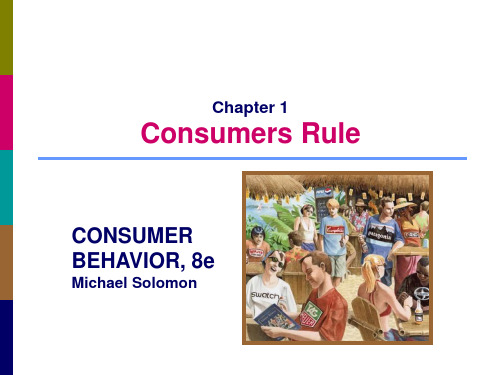
What is Consumer Behavior?
Consumer behavior: the study of the processes involved when individuals or groups select, purchase, use, or dispose of products, services, ideas, or experiences to satisfy needs and desires.
Gail, business student and consumer
• Segmented by marketers by
demographics • Market segmentation: targeting a brand to specific groups of consumers
• Influenced by peer groups (such as
Chapter 1
Consumers Rule
CONSUMER BEHAVIOR, 8e
Michael Solomon
Chapter Objectives
When you finish this chapter you should understand why:
• Consumer behavior is a process. • Consumers use products to help them define their
Segmenting Consumers: Demographics
Demographics: statistics that measure observable aspects of a population, such as:
消费者行为学课件-消费者学习与态度
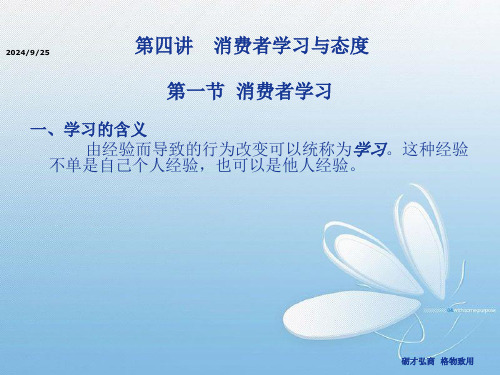
4/9/25
〔三〕认知学习理论
1.映像式机械学习
指在没有条件作用的情况下学习 在两个和多个概念之间建立联想。
一个简单信息无数次贬低重复可 以导致消费者一看到某种环境就联想到该 信息,形成关于产品属性和特征的信息, 一旦有了需要,就会受到这种信念的支配 而购置产品。
砺才弘商 格物致用
刺激的分化或区分是指消费者对特定的刺激 引起特定的反响。或是从类似的刺激中选 择正确的刺激作出反响。刺激的分化在市 场营销中起着产品定位的作用。
砺才弘商 格物致用
〔二〕操作性条件反射理论
2024/9/25
操作条件反射理论,也称工 具性条件反射。是由美国 著名心理学家斯金纳提出 的。
1.操作条件反射理论的内容 学习是一种反响概率上的变
化,而强化是增强反响概 率的手段。如果一个操作 或自发反响出现之后,有 强化物或强化刺激相尾随, 那么该反响出现的概率就 增加。
砺才弘商 格物致用
2.操作性条件反射作用在市场营销中的运用
2024/9/25
❖ 强化 : 增强某种刺激与个 体某种反响之间的联系。
❖ 积极强化(正强化): 某些 事件或结果可以增加特定 行为重复发生的频率。
2024/9/25
1.经典条件反射的根本内 容: 揭示了刺激与反 响之间的关系,并借 助于刺激与反响之间 已有的关系,经由练 习而建立另一种刺激 与同样反响之间的关 系,从而科学地说明 了学习的生理根底是 条件反射,是大脑分 析活动的结果。
砺才弘商 格物致用
2.经典条件反射原理对营销和消费者行为研究
2024/92/25 、观察学习理论 观察学习也称模仿学习、替代学习、社会学习等,是指通 过观察他人及他人的行为结果而改变自身行为的过程。 3.推理 推理:指个体对已有的信息和新信息进行重新构造和组合 以进行创造性思考。推理是认知学习最复杂的形式。
〔三〕认知学习理论
1.映像式机械学习
指在没有条件作用的情况下学习 在两个和多个概念之间建立联想。
一个简单信息无数次贬低重复可 以导致消费者一看到某种环境就联想到该 信息,形成关于产品属性和特征的信息, 一旦有了需要,就会受到这种信念的支配 而购置产品。
砺才弘商 格物致用
刺激的分化或区分是指消费者对特定的刺激 引起特定的反响。或是从类似的刺激中选 择正确的刺激作出反响。刺激的分化在市 场营销中起着产品定位的作用。
砺才弘商 格物致用
〔二〕操作性条件反射理论
2024/9/25
操作条件反射理论,也称工 具性条件反射。是由美国 著名心理学家斯金纳提出 的。
1.操作条件反射理论的内容 学习是一种反响概率上的变
化,而强化是增强反响概 率的手段。如果一个操作 或自发反响出现之后,有 强化物或强化刺激相尾随, 那么该反响出现的概率就 增加。
砺才弘商 格物致用
2.操作性条件反射作用在市场营销中的运用
2024/9/25
❖ 强化 : 增强某种刺激与个 体某种反响之间的联系。
❖ 积极强化(正强化): 某些 事件或结果可以增加特定 行为重复发生的频率。
2024/9/25
1.经典条件反射的根本内 容: 揭示了刺激与反 响之间的关系,并借 助于刺激与反响之间 已有的关系,经由练 习而建立另一种刺激 与同样反响之间的关 系,从而科学地说明 了学习的生理根底是 条件反射,是大脑分 析活动的结果。
砺才弘商 格物致用
2.经典条件反射原理对营销和消费者行为研究
2024/92/25 、观察学习理论 观察学习也称模仿学习、替代学习、社会学习等,是指通 过观察他人及他人的行为结果而改变自身行为的过程。 3.推理 推理:指个体对已有的信息和新信息进行重新构造和组合 以进行创造性思考。推理是认知学习最复杂的形式。
希夫曼 《消费者行为学(第12版)》英文教学课件CH4

Copyright © 2019 Pearson Education, Ltd. All Rights Reserved.
Learning Objective 4.4
4.4 To understand how people organize stimuli.
Copyright © 2019 Pearson Education, Ltd. All Rights Reserved.
Copyright © 2019 Pearson Education, Ltd. All Rights Reserved.
Discussion Questions (1 of 2)
What is the difference between the absolute threshold and the differential threshold (JND)? Why do marketers care about sensory adaptation?
Learning Objectives (1 of 2)
4.1 To understand how perception shapes sensory input and subsequent consumer behavior. 4.2 To understand the distinction between the sensory absolute and differential thresholds. 4.3 To understand why consumers notice some stimuli but not others. 4.4 To understand how people organize stimuli. 4.5 To understand how consumers use integral and external factors to evaluate products.
Learning Objective 4.4
4.4 To understand how people organize stimuli.
Copyright © 2019 Pearson Education, Ltd. All Rights Reserved.
Copyright © 2019 Pearson Education, Ltd. All Rights Reserved.
Discussion Questions (1 of 2)
What is the difference between the absolute threshold and the differential threshold (JND)? Why do marketers care about sensory adaptation?
Learning Objectives (1 of 2)
4.1 To understand how perception shapes sensory input and subsequent consumer behavior. 4.2 To understand the distinction between the sensory absolute and differential thresholds. 4.3 To understand why consumers notice some stimuli but not others. 4.4 To understand how people organize stimuli. 4.5 To understand how consumers use integral and external factors to evaluate products.
消费者行为学PPT54页

消费者满意的形成过程
消费者预期
感知的性能
Disconfirmation
满意不满
情感
+
—
影响消费者满意的因素
产品品质与性能(工具性性能、像征性性能)消费者特征促销影响消费者态度与期望竞争产品状况对公平的感知消费者归因
品牌忠诚与重复购买
重复购买分习惯型购买和忠诚型购买品牌忠诚,是消费者对某一品牌形成强烈的情感偏好,试图重复选择该品牌的倾向品牌忠诚对企业营销的意义品牌忠诚形成的原因
六、 购后行为
产品的获得
购买后冲突
产品的满意/不满意
品牌忠诚度
产品处置
消费者抱怨行为
产品的使用/闲置
列举所知的顾客忠诚度计划的表现形式?
消费者满意与不满
消费者满意的含义 消费者对产品或服务的期望水平与实际水平之间的主观比较,它反映产品和服务在多大程度上满足顾客的需要与欲望消费者满意的结果正面口传增加使用重复购买品牌忠诚
捕获战略
捕获战略 如果我们的品牌属于被考虑的品牌之列,目标应是尽可能占有较大的购买份额。由于消费者从事有限的信息搜集,我们需要了解他们在何处搜寻信息和搜寻何种信息合作性广告通过购物点的陈列足够大的货架空间
拦截战略
如果目标消费者从事有限决策,而我们的品牌又不在其激活域中,公司的目标将是在消费者寻找有关激活域品牌的信息过程中对其实施拦截。地方媒体上的合作性广告购物点陈列、货架空间包装设计赠送奖券也非常有效 由于消费者对我们的品牌不予关注,吸引消费者的注意将至关重要。
选择
使用
结果强化惩罚
购买评价与选择过程:理智型
评价标准标准重要程度所考虑的备选产品
基于评价标准对每一备选产品进行评价
确定决策规则
消费者预期
感知的性能
Disconfirmation
满意不满
情感
+
—
影响消费者满意的因素
产品品质与性能(工具性性能、像征性性能)消费者特征促销影响消费者态度与期望竞争产品状况对公平的感知消费者归因
品牌忠诚与重复购买
重复购买分习惯型购买和忠诚型购买品牌忠诚,是消费者对某一品牌形成强烈的情感偏好,试图重复选择该品牌的倾向品牌忠诚对企业营销的意义品牌忠诚形成的原因
六、 购后行为
产品的获得
购买后冲突
产品的满意/不满意
品牌忠诚度
产品处置
消费者抱怨行为
产品的使用/闲置
列举所知的顾客忠诚度计划的表现形式?
消费者满意与不满
消费者满意的含义 消费者对产品或服务的期望水平与实际水平之间的主观比较,它反映产品和服务在多大程度上满足顾客的需要与欲望消费者满意的结果正面口传增加使用重复购买品牌忠诚
捕获战略
捕获战略 如果我们的品牌属于被考虑的品牌之列,目标应是尽可能占有较大的购买份额。由于消费者从事有限的信息搜集,我们需要了解他们在何处搜寻信息和搜寻何种信息合作性广告通过购物点的陈列足够大的货架空间
拦截战略
如果目标消费者从事有限决策,而我们的品牌又不在其激活域中,公司的目标将是在消费者寻找有关激活域品牌的信息过程中对其实施拦截。地方媒体上的合作性广告购物点陈列、货架空间包装设计赠送奖券也非常有效 由于消费者对我们的品牌不予关注,吸引消费者的注意将至关重要。
选择
使用
结果强化惩罚
购买评价与选择过程:理智型
评价标准标准重要程度所考虑的备选产品
基于评价标准对每一备选产品进行评价
确定决策规则
消费者行为学课件_chapter4_learning and memory

3-3
Learning Theories
• Psychologists who study learning have advanced several theories to explain the learning process. – behavioral theories focus on simple stimulusresponse connections – cognitive theories are perspectives that regard consumers as complex-problem solvers who learn abstract rules and concepts by observing others.
3-19
工具性条件反射 (instrumental conditioning)
• 理解:又称操作性条件反射,指个体学会那些能产生积极 结果并避免负面结果的行为 • 重要概念
– 强化:正强化(奖赏)、负强化(恐吓,归避) – 惩罚 – 塑造
负强化与惩罚的区别
• 负强化:
–当有机体自发作出某种反应之后,随即排除或避免 了某种讨厌刺激或不愉快情境,从而使此类反应在 以后的类似情境中发生的概率增加,这种操作即为 负强化。
习惯成自然!
3-12
Mini case
• In the 1980’s, the Lacoste crocodile was an exclusive logo symbolizing casual elegance(闲情雅致). When it was repeated on baby clothes and other items, it lost its cache(珍稀特质) and began to be replaced by contenders(竞争者) such as the Ralph Lauren Polo Player.
消费者行为学课件III-4-5
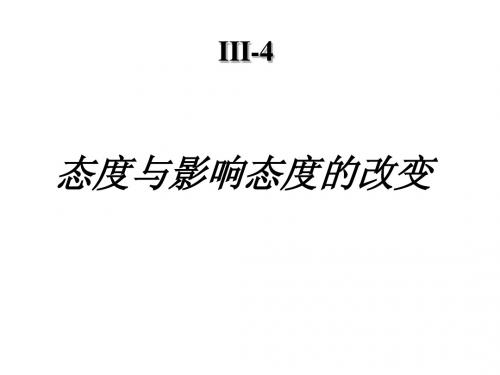
倾向 1) 相信某些人会想我应该有 或者不应该有这样的行为 与这些人保持一致的动机 主观标准
行为
2)
Theory of Planned Behavior模型
行为态度
主观标准
倾向
行为
感知行 为控制
多属性态度模型
Ab X ib
i 1
n
Ab 表示消费者对某特定品牌 b 的态度; Xib 表示消费者对品牌 b 的属性i的信念; N 表示属性的数目.
营销信息展露 中央通道 外围通道
对产品、信息和决策的高介入
对产品、信息和决策的低介入
强烈关注中心属性、 与产品相关的特性和事实信息
对外围的、与产品无关的特征 和情感给与某些关注
对产品属性和使用结果进行有 意识的思考;大量的评价
地水平或无意识的信息处理, 很少或低水平的评价
劝说由经典条件反射起作用;情 感态度改变,和无意识信念改变 导致态度和行为的改变
自我意识 时尚导向的 绿色女神(美女) 不在乎型 内疚的 邋塌的 162 147 95 82 68 37 188 166 76 81 59 19 228 153 74 70 53 17 189 165 86 89 40 22 151 118 119 74 82 52 102 112 103 95 99 85 51% 43% 32% 44% 24% 20% 60% 56% 52% 64% 59% 62%
2 易激动的______ : ______ : ______ : ______ : ______ : ______ : ______沉着的 3 不舒服的______ : ______ : ______ : ______ : ______ : ______ : ______舒服的
- 1、下载文档前请自行甄别文档内容的完整性,平台不提供额外的编辑、内容补充、找答案等附加服务。
- 2、"仅部分预览"的文档,不可在线预览部分如存在完整性等问题,可反馈申请退款(可完整预览的文档不适用该条件!)。
- 3、如文档侵犯您的权益,请联系客服反馈,我们会尽快为您处理(人工客服工作时间:9:00-18:30)。
4-19
For Reflection
• Describe your level of involvement with the
“product” and devise some marketing opportunities to reach this group.
4-20
Learning Objective 3
To me (object to be judged) is:
1. important
_:_:_:_:_:_:_
unimportant
2. boring
_:_:_:_:_:_:_
interesting
3. relevant
_:_:_:_:_:_:_
irrelevant
4. exciting
_:_:_:_:_:_:_
Focus on products that allow them to have mastery over surroundings (muscle cars, loud boom-boxes)
NEED FOR UNIQUENESS
Assert one’s individual identity
Enjoy products that focus on their unique character (perfumes, clothing)
expectations of achieving desirable outcomes
4-7
What Do We Need?
Biogenic Needs Psychogenic Needs
Utilitarian Needs Hedonic Needs
4-8
Motivational Conflicts
9. involving
_:_:_:_:_:_:_
uninvolving
10. not needed
_:_:_:_:_:_:_
needed
4-18
Purchase Situation Involvement
• Purchase situation involvement:
differences that occur when buying the same object for different contexts.
NEED FOR AFFILIATION
Want to be with other people
Focus on products that are used in groups (alcoholic beverages, sports bars)
NEED FOR POWER
Control one’s environment
• I like to work in the soil (physiological) • I feel safe in my garden (safety) • I can share my produce with others (affiliation) • I can create something of beauty (esteem) • My garden gives me a sense of peace (self-
willingness to expend energy to reach a goal
• Drive theory: biological needs that produce
unpleasant states of arousal (e.g., hunger)
• Expectancy theory: behavior is pulled by
4-16
Levels of Involvement: From Inertia to Passion
• Inertia is consumption at the low end of
involvement; decisions made out of habit (lack of motivation)
Chapter 4 Motivation and Global Values
CONSUMER BEHAVIOR, 10e
Michael R. Solomon
4-1
Learning Objectives
When you finish this chapter, you should understand why:
fail in another if marketers fail to understand the differences among consumers in each place.
6. Western cultures have a huge impact
around the world, although people in other countries don’t necessarily ascribe the same meanings to products we do.
• Our deeply held cultural values dictate the
types of products and services we seek out or avoid.
4-21
consumer’s head
• Lucky magazine for women who
obsess over shopping
• A man tried to marry his car when his
fiancée dumped him
4-15
Figure 4.3 Conceptualizing Involvement
unexciting
5. means nothing
_:_:_:_:_:_:_
means a lot
6. appealing
_:_:_:_:_:_:_
unappealing
7. fascinating
_:_:_:_:_:_:_
mundane
8. worthless
_:_:_:_:_:_:_
valuable
• Example: wedding gift • For boss: purchase expensive vase to
show that you want to impress boss
• For cousin you don’t like: purchase
inexpensive vase to show you’re indifferent
4-4
Learning Objective 1
• It is important for
marketers to recognize that products can satisfy a range of consumer needs.
4-5
Needs and Motivation
• Needs may be utilitarian or hedonic • The desired end state is the goal • The degree of arousal is drive • Personal and cultural factors combine to
• Goal valence (value): consumer will: • Approach positive goal • Avoid negative goal
• Example: Partnership for a Drug-Free
America communicates negative consequences of drug addiction for those tempted to start
4-14
Consumer Involvement
• Involvement: perceived relevance of an
object based on one’s needs, values, and interests
• We get attached to products: • “All in One” restaurant tattoo on
4-9
Figure 4.1 Types of Motivational Conflicts
• Two desirable alternatives • Cognitive dissonance
• Positive & negative aspects of desired product
• Guilt of desire occurs
4-11
Levels of Needs in the Maslow Hierarchy
4-12
For Reflection
• Some studies show that an activity can satisfy
every level of Maslow’s hierarchy. What does this say about the hierarchy?
• Flow state occurs when consumers are
truly involved
• Sense of control • Concentration • Mental enjoyment • Distorted sense of time
4-17
Table 4.1 Measuring Involvement
1. It’s important for marketers to recognize
that products can satisfy a range of consumer needs.
For Reflection
• Describe your level of involvement with the
“product” and devise some marketing opportunities to reach this group.
4-20
Learning Objective 3
To me (object to be judged) is:
1. important
_:_:_:_:_:_:_
unimportant
2. boring
_:_:_:_:_:_:_
interesting
3. relevant
_:_:_:_:_:_:_
irrelevant
4. exciting
_:_:_:_:_:_:_
Focus on products that allow them to have mastery over surroundings (muscle cars, loud boom-boxes)
NEED FOR UNIQUENESS
Assert one’s individual identity
Enjoy products that focus on their unique character (perfumes, clothing)
expectations of achieving desirable outcomes
4-7
What Do We Need?
Biogenic Needs Psychogenic Needs
Utilitarian Needs Hedonic Needs
4-8
Motivational Conflicts
9. involving
_:_:_:_:_:_:_
uninvolving
10. not needed
_:_:_:_:_:_:_
needed
4-18
Purchase Situation Involvement
• Purchase situation involvement:
differences that occur when buying the same object for different contexts.
NEED FOR AFFILIATION
Want to be with other people
Focus on products that are used in groups (alcoholic beverages, sports bars)
NEED FOR POWER
Control one’s environment
• I like to work in the soil (physiological) • I feel safe in my garden (safety) • I can share my produce with others (affiliation) • I can create something of beauty (esteem) • My garden gives me a sense of peace (self-
willingness to expend energy to reach a goal
• Drive theory: biological needs that produce
unpleasant states of arousal (e.g., hunger)
• Expectancy theory: behavior is pulled by
4-16
Levels of Involvement: From Inertia to Passion
• Inertia is consumption at the low end of
involvement; decisions made out of habit (lack of motivation)
Chapter 4 Motivation and Global Values
CONSUMER BEHAVIOR, 10e
Michael R. Solomon
4-1
Learning Objectives
When you finish this chapter, you should understand why:
fail in another if marketers fail to understand the differences among consumers in each place.
6. Western cultures have a huge impact
around the world, although people in other countries don’t necessarily ascribe the same meanings to products we do.
• Our deeply held cultural values dictate the
types of products and services we seek out or avoid.
4-21
consumer’s head
• Lucky magazine for women who
obsess over shopping
• A man tried to marry his car when his
fiancée dumped him
4-15
Figure 4.3 Conceptualizing Involvement
unexciting
5. means nothing
_:_:_:_:_:_:_
means a lot
6. appealing
_:_:_:_:_:_:_
unappealing
7. fascinating
_:_:_:_:_:_:_
mundane
8. worthless
_:_:_:_:_:_:_
valuable
• Example: wedding gift • For boss: purchase expensive vase to
show that you want to impress boss
• For cousin you don’t like: purchase
inexpensive vase to show you’re indifferent
4-4
Learning Objective 1
• It is important for
marketers to recognize that products can satisfy a range of consumer needs.
4-5
Needs and Motivation
• Needs may be utilitarian or hedonic • The desired end state is the goal • The degree of arousal is drive • Personal and cultural factors combine to
• Goal valence (value): consumer will: • Approach positive goal • Avoid negative goal
• Example: Partnership for a Drug-Free
America communicates negative consequences of drug addiction for those tempted to start
4-14
Consumer Involvement
• Involvement: perceived relevance of an
object based on one’s needs, values, and interests
• We get attached to products: • “All in One” restaurant tattoo on
4-9
Figure 4.1 Types of Motivational Conflicts
• Two desirable alternatives • Cognitive dissonance
• Positive & negative aspects of desired product
• Guilt of desire occurs
4-11
Levels of Needs in the Maslow Hierarchy
4-12
For Reflection
• Some studies show that an activity can satisfy
every level of Maslow’s hierarchy. What does this say about the hierarchy?
• Flow state occurs when consumers are
truly involved
• Sense of control • Concentration • Mental enjoyment • Distorted sense of time
4-17
Table 4.1 Measuring Involvement
1. It’s important for marketers to recognize
that products can satisfy a range of consumer needs.
